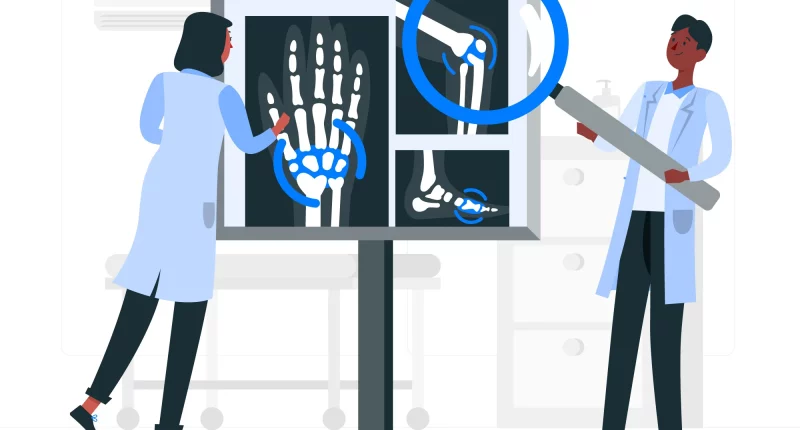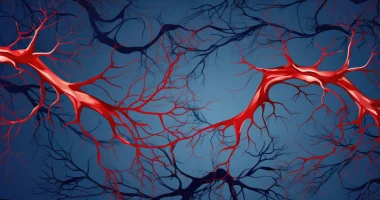Bone cancer starts in the bones and damages the surrounding tissue. Primary and secondary are the two important kinds of bone cancer. Surgery is the most common treatment, and if the cancer is found early and treated properly, the chances of recovery are good.
Primary bone cancer begins directly in the bone cells. Secondary bone cancer happens when cancer from another part of the body spreads to the bones.
The National Cancer Institute says that primary bone cancer is very rare, making up less than one percent of all cancers. When it comes to secondary bone cancer, is more common.
Bone cancer may also spread to other parts of the body, like the lungs.
Types of Bone Cancer
Bone cancer can be classified into several types, primarily based on whether they originate in the bone or spread from another part of the body.
Primary Bone Cancers
Primary bone cancers start in the bone itself and can be either malignant (cancerous) or benign (noncancerous). Benign tumors remain localized and do not spread, whereas malignant tumors are more dangerous and have a higher potential to grow and metastasize.
Osteosarcoma
This cancer originates in osteoblasts, the cells responsible for bone formation. It is the most common kind of bone cancer and primarily affects individuals aged between 10-19 years. Osteosarcoma is the third most common cancer that affects teenagers in the United States. Conditions like Paget’s disease, which causes abnormal bone growth, can increase the chance of developing this type of bone cancer.
Ewing Sarcoma
It typically grows in the pelvis, shinbone, chest wall, or thighbone, but it can also affect soft tissues like fat, blood vessels, and muscle. This tumor grows rapidly and frequently spreads to other body parts like the lungs. It is most common in individuals aged 10-19 years and is the second most frequent bone cancer in children and teenagers, though it remains rare.
Chondrosarcoma
This type of cancer starts in the cartilage, a connective tissue lining the joints, and then transmits to the bone. Chondrosarcoma most frequently affects adults over 40 years old and usually grows in the pelvis, upper leg, and shoulders. It generally grows slowly.
Chordoma
Chordoma is an uncommon cancer that occurs in the spine, typically at the end of the spine and skull in old individuals. However, it can also grow in children and teenagers, usually beginning at the base of the skull and neck.
Secondary Bone Cancers
Secondary bone cancers are the most frequent type of bone cancer in adults. They grow when cancer from another area of the body extends to the bones, a process known as metastasis. Individuals with prostate and breast cancer have a specifically high chance of growing secondary bone cancer. This kind of cancer can lead to significant symptoms, including fractures, pain, and hypercalcemia (the higher quantity of calcium in the blood).
Treatment of Bone Cancer
The treatment for bone cancer relies on several elements, including the kind of bone cancer, its place in the body, its aggressiveness, and whether it has an extension.
Surgery
Surgery is the most common treatment for bone cancer. The goal is to eliminate the tumor and some of the surrounding bone tissue. If any cancer cells are left behind, they may persist to grow and spread.
Limb-sparing surgery allows the surgeon to rule out the cancer without amputating the limb. To utilize the limb again, reconstructive surgery may be necessary, where bone from another area of the body or an artificial bone is used to replace the lost bone. In some cases, amputation may be required to completely rule out the cancer, although this is becoming rarer as surgical techniques improve.
Radiation Therapy
Radiation therapy is commonly used to treat many types of cancer. It involves targeting cancer cells with high-energy X-rays to eliminate them. Radiation therapy can be used alongside surgery or as a standalone treatment. It is a correct treatment for Ewing sarcoma and is often part of combination therapy, where it is combined with another type of treatment for greater effectiveness.
Chemotherapy
Chemotherapy uses medications to eliminate cancer cells. It is commonly used for individuals with Osteosarcoma or Ewing sarcoma. Sometimes, chemotherapy is combined with radiation therapy for better results.
Cryosurgery
Cryosurgery is an alternative to traditional surgery for eliminating tumors from bone tissue. In this technique, a surgeon uses liquid nitrogen to stop and destroy cancer cells.
Targeted Therapy
Targeted therapy involves using drugs designed to meet specifically with molecules that lead to cancer cells developing. One such drug is Denosumab (Xgeva), a monoclonal antibody approved by the U.S. Food and Drug Administration for use in adolescents and adults with fully grown skeletons. Denosumab stops osteoclasts, a type of blood cell, from damaging bone tissue.
Risk Factors for Bone Cancer
The precise cause of bone cancer remains unclear, and more research is needed to fully understand it. However, the American Cancer Society identifies several risk factors that may increase the likelihood of developing bone cancer. One significant factor is genetics. People with long-lasting inflammatory diseases, like Paget’s disease, might also have a slightly higher chance of getting bone cancer in some phase of their life.
Despite these known risk factors, it is still not understood why some people develop bone cancer while others do not.
The risk factors are:
- Being younger than 20 years old
- Getting contact with the radiation, like radiation therapy for another cancer
- Bone marrow transplant treatment in the past
- A person with a bone cancer in a family
- Hereditary retinoblastoma, a kind of eye cancer that most frequently grows in children
Symptoms of Bone Cancer
The primary symptom of bone cancer is usually persistent, nagging pain in the affected area. After a while, this pain becomes more severe and continuous. In some cases, the pain may be subtle, causing individuals to delay seeking medical attention for several months. The pain progression is likely to be faster with Ewing sarcoma compared to other types of bone cancer.
Other common symptoms of bone cancer include:
- Inflammation in the affected area
- Fragile and weak bones that are more prone to fractures
- Losing weight unintentionally
Although much less common, some people with bone cancer may also experience night sweats chills, and fever.
Diagnosis of Bone Cancer
To diagnose bone cancer, a healthcare provider may first order a blood test to eliminate other probable causes. If bone cancer is suspected, the individual will be referred to a bone specialist and may require the following tests:
- Radionuclide Bone Scan: This scan can detect whether cancer has extended to other bones, finding tiny areas of extended cancer.
- CT scans: These scans can show the extent to which the cancer has spread.
- MRI Scan: This scan provides a detailed tumor outline.
- PET Scan: This scan is useful for examining the entire body for the presence of cancer.
- X-rays: This cancer is typically visible on X-rays. An X-ray on the chest can determine if the cancer has extended to the lungs and other body parts.
Biopsy
To determine the stage and grade of a tumor, and to assess whether it is malignant or benign, a healthcare provider may perform a biopsy. Several types of biopsies are available for individuals with bone cancer:
- Fine Needle Aspiration: The healthcare providers use a fine needle to extract a small number of cells and tumors from the bone tumor, which is then examined under a microscope.
- Core Needle Biopsy: A larger needle is utilized to take a more substantial tissue sample.
- Incisional Biopsy: The healthcare provider makes an incision in the skin by following general anesthesia to eliminate a small tissue sample for examination.
- Excisional Biopsy: The entire tumor is removed by following general anesthesia for examination.
Outlook for Bone Cancer
The outlook for someone with cancerous bone cancer largely depends on whether the cancer has spread to other areas of the body.
For instance, if someone has chondrosarcoma that has not transmit, they have a 91% possibility of surviving for five years after being diagnosed. But the cancer has spread to far areas like the lungs, and the five-year survival rate falls to 33%. Overall, considering all stages of bone cancer, the American Cancer Society estimates an 80% five-year survival rate.
Detecting and treating bone cancer early is crucial for improving the chances of survival.
Summary
Bone cancer can be primary or secondary, originating in bones or spreading from elsewhere. Primary bone cancers include osteosarcoma, Ewing sarcoma, and chondrosarcoma, each with specific characteristics and treatments like surgery, radiation, and chemotherapy. Secondary bone cancer commonly stems from breast or prostate cancer metastases.
Symptoms include persistent pain, swelling, and fractures. Diagnosis involves scans and biopsies to confirm cancer presence and type. Treatment outcomes vary based on early detection; survival rates can range from 91% for localized cancers to lower percentages if cancer spreads.








